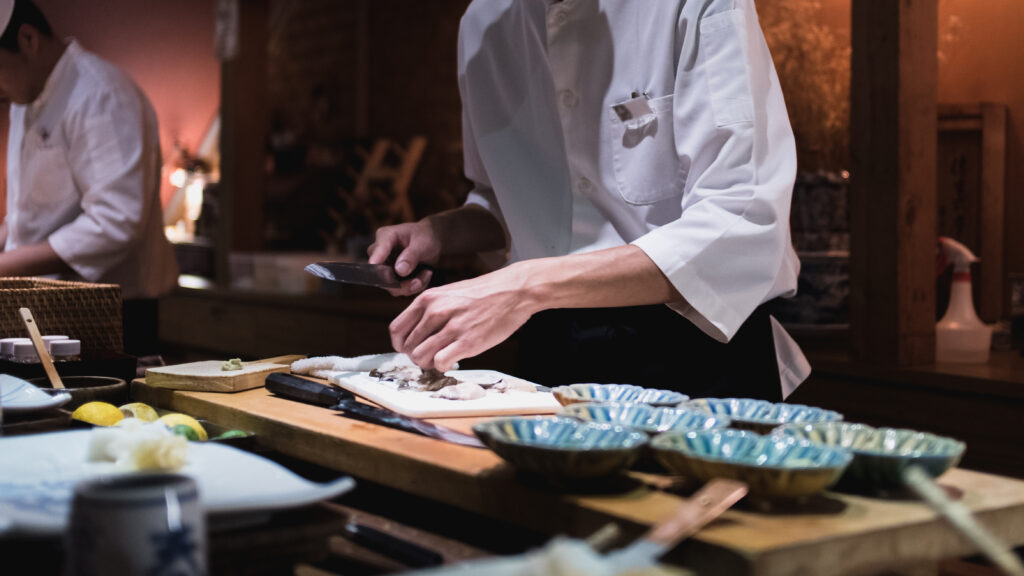
To immerse yourself in Japanese cuisine is to open up to a world of unique flavors and age-old traditions. Whether you're a fan of sushi or curious to discover lesser-known dishes, Japan offers a culinary diversity that will delight your taste buds with every bite. In this article, we present 19 must-try specialties during your stay in the land of the rising sun. From the unmissable ramen to delicate tempura and bold fugu, each dish invites you to a true sensory experience. Get your chopsticks ready, and let's set off on a gastronomic journey through Japan!
Discover our Japanese must-tries!
1- Sushi

Sushi is undoubtedly the most recognized emblem of Japanese cuisine. Made from delicately shaped vinegared rice, it is often accompanied by raw fish, seafood or vegetables. The varieties are endless: nigiri, maki, sashimi... Each bite is an explosion of flavors. Although sushi has been exported all over the world, nothing beats the experience of tasting it on the spot in Japan, where the freshness of the ingredients and the skill of the chefs transform this dish into a veritable culinary art. Be sure to try the different versions to truly appreciate the diversity of this specialty.
Visiting Tokyo? Take the opportunity to take a sushi-making class !
2- Ramen
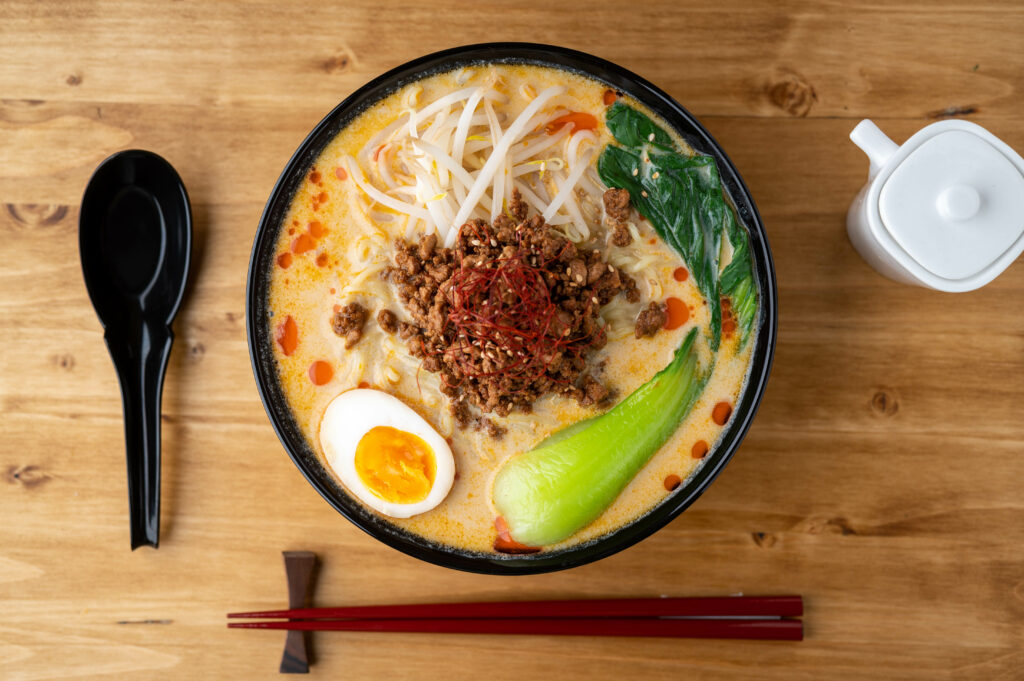
Ramen is a staple of Japanese cuisine, perfect for a comforting meal at any time of day. This bowl of noodles dipped in a savory broth can be garnished with slices of pork, vegetables, eggs and sometimes seaweed. Depending on the region, the broth may vary: miso, shoyu (soy sauce), or tonkotsu (pork bone) are the most popular. Each bowl of ramen offers a unique taste experience. Whether you're in Tokyo or Kyoto, be sure to try this iconic dish, a mainstay of Japanese street food.
Learn how to make ramen from A to Z right in Kyoto !
3- Tempura
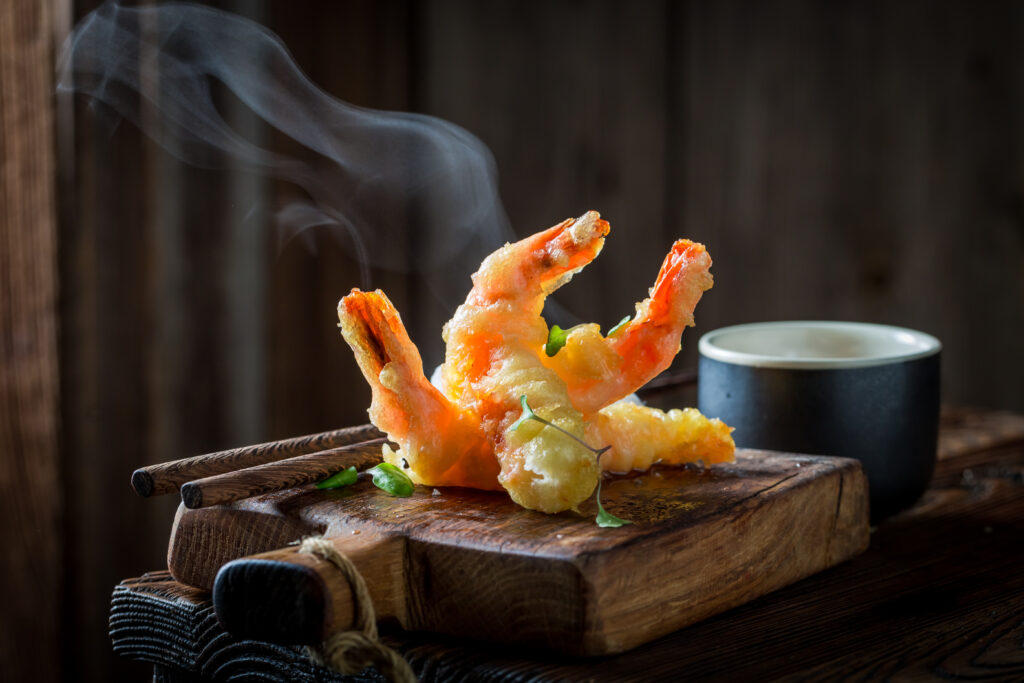
Tempura is an emblematic dish of Japanese cuisine, appreciated for its lightness and crispy texture. Imported from Portugal in the 16th century, tempura was perfected by Japanese chefs to become what we know today. Pieces of vegetable or seafood are coated in a light batter before being fried to perfection. The result? A bite that's crispy on the outside and tender on the inside. You'll find this delicacy in specialized restaurants in Japan, often accompanied by a light sauce and a bowl of rice. Tempura is a must for those who want to discover the art of Japanese deep-frying without the heaviness.
Opt for a cooking class in Osaka to learn how to make authentic tempura and miso soup!
4- Okonomiyaki
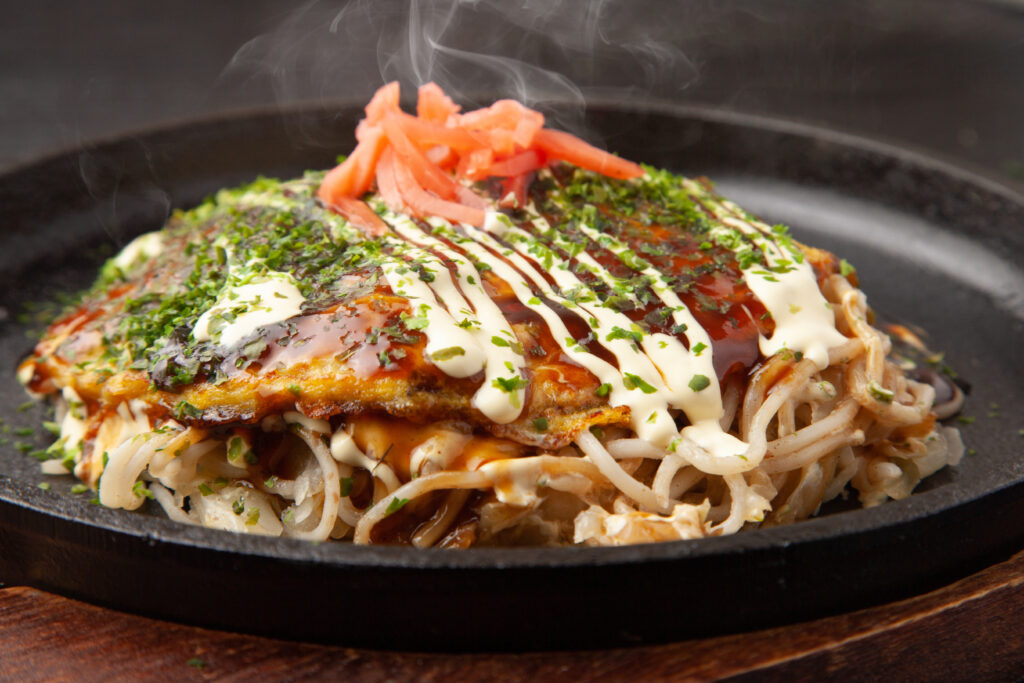
Okonomiyaki is often dubbed the "Japanese pizza", but it's much more than just a pancake. Particularly popular in Osaka and Hiroshima, this dish is made from a dough of flour, eggs and cabbage, topped to taste. You can add pork, seafood, cheese or even noodles. The whole thing is cooked on a hot plate and served with a special sauce, mayonnaise, dried seaweed and bonito flakes.Okonomiyaki perfectly embodies the Japanese philosophy of "do it the way you like it", offering a culinary experience that's both customizable and delicious. Be sure to try it on your visit to Japan to discover this unique fusion of flavors.
You might also like to read about Osaka's must-tries!
5- Takoyaki

Takoyaki is a true icon of Japanese street food, particularly popular in the Kansai region, and more specifically in Osaka. These small dumplings, filled with pieces of octopus, are baked in special molds that give them their characteristic round shape. Once golden, takoyaki are generously topped with takoyaki sauce, sprinkled with dried bonito flakes and sometimes mayonnaise. Served piping hot, they are both crispy on the outside and soft on the inside, offering an irresistible blend of textures and flavors. Whether you sample them at a festival or from a street vendor, takoyaki is a must for any traveler curious about authentic Japanese cuisine.
6- Udon

Udon are thick, chewy noodles that are a staple of Japanese cuisine. They are generally made from wheat flour and can be served hot in a savory broth, or cold with a dipping sauce. Udon are particularly appreciated for their comforting texture and versatility: they can be found in a multitude of dishes, from simple soups to more elaborate dishes such as kare udon (curry udon). Whether in the middle of winter to warm up, or in summer as a refreshing dish, udon are the perfect choice for discovering the richness of Japanese gastronomy. These noodles are adaptable to all seasons and are a must for any lover of Japanese cuisine.
7- Soba

Soba are fine buckwheat noodles that play a central role in Japanese gastronomy. Versatile and tasty, they can be served hot in a light broth or cold, accompanied by a soaking sauce called tsuyu. In summer, cold soba, often topped with nori (seaweed) and wasabi, offer a refreshing meal, while hot versions are perfect for the cooler months. Rich in nutrients thanks to buckwheat, soba are not only delicious, but also good for your health. Whether you're enjoying them in a small traditional restaurant or at a family meal, soba is a real must-have for any lover of authentic Japanese cuisine.
8- Kare Raisu

Kare Raisu, or Japanese curry, is a very popular comfort dish in Japan. Inspired by Indian curry, it is distinguished by its thick, slightly sweet sauce, often flavored with curry, and accompanied by vegetables such as carrots, onions and potatoes. This dish is served on a bed of fluffy white rice, sometimes with breaded pork or chicken called katsu. Easy to find in Japanese restaurants and homes, Kare Raisu is a veritable institution, appreciated for its simplicity and comforting flavor. If you're looking to discover a different aspect of Japanese cuisine, be sure to try this rich, flavorful dish, ideal for a hearty, hearty meal.
9- Yakitori

Yakitori are delicious chicken skewers, grilled to perfection, and a true classic of Japanese cuisine. Often served in izakayas (Japanese tapas bars), these skewers are made up of various pieces, such as chicken, livers or even skin, seasoned simply with salt or a sweet-salty soy-based sauce called tare. Perfectly suited to be enjoyed with beer or sake, yakitori are an ideal choice for a convivial meal with friends or a quick snack on a stroll around town. These skewers embody the simplicity and efficiency of Japanese street food, offering rich, varied flavors in every bite.
Don't want to choose between all these dishes? Opt for a shinsekai culinary tour with 13 dishes in 5 traditional restaurants !
10- Tonkatsu

Tonkatsu is a simple, tasty Japanese dish, consisting of a pork cutlet breaded and fried to perfection. After being coated in flour, beaten egg and panko (Japanese breadcrumbs), the meat is fried to a crisp, golden crust. This dish is usually served with grated cabbage and a sweet and sour tonkatsu sauce, reminiscent of Worcestershire sauce. Accompanied by a bowl of rice and sometimes miso soup, Tonkatsu is a perfect example of the fusion between Western and Japanese cuisine, offering a culinary experience that is both comforting and delicious. Ideal for a hearty meal, Tonkatsu is a must for those wishing to discover another facet of Japanese gastronomy
11- Onigiri

Onigiri is a simple yet iconic Japanese snack, found everywhere in Japan, from konbinis (convenience stores) to homemade bentos. These compact rice dumplings are hand-formed into triangular or round shapes, often topped with a tasty heart such as grilled salmon, salted plum (umeboshi), or tuna-mayonnaise. Wrapped in a sheet of nori (seaweed), onigiri are both practical and delicious, perfect for a quick break or lunch on the go. With their combination of simplicity and flavor, onigiri perfectly embody the philosophy of Japanese cuisine: do a lot with a little, while being rooted in tradition.
Make your own onigiri at Tokyo Temple!
12- Gyoza
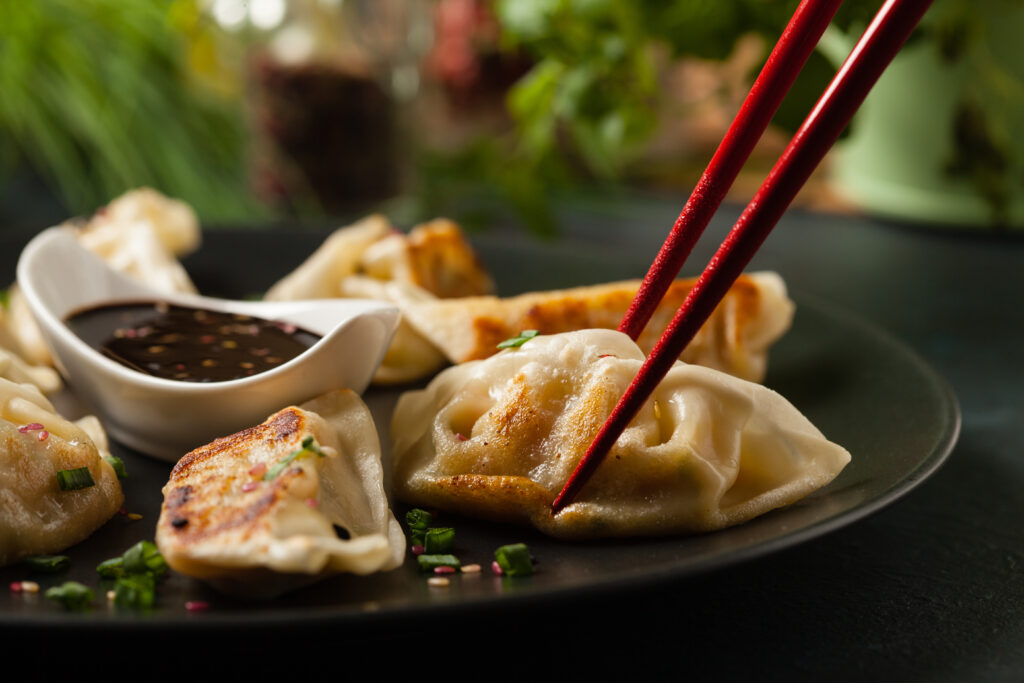
Gyoza are Japanese ravioli, directly inspired by Chinese jiaozi, but with a uniquely Japanese twist. Stuffed with minced pork, cabbage, garlic and ginger, they are often grilled on one side, giving them a crispy yet chewy texture. Gyoza are usually served with a soy and vinegar-based sauce, which enhances their flavor. Whether as an appetizer, side dish, or even for an evening out with friends, these irresistible morsels are perfect for any occasion. Easy to find in izakayas (Japanese tapas bars) or to prepare at home, gyoza are a real treat for lovers of Japanese cuisine.
13- Mochi

Mochi is a traditional Japanese sweet made from glutinous rice pounded to a smooth, elastic texture. This dessert, often eaten during New Year celebrations, comes in many varieties, each offering a unique experience. Among the most popular are daifuku mochi, filled with sweetened red bean paste (anko), and iced mochi, which encase a scoop of ice cream. Despite their simple appearance, mochi are appreciated for their unique texture and ability to capture the authentic flavors of Japan. Whether at the end of a meal or as a snack, Mochi perfectly embodies the essence of Japanese confectionery: delicate, subtle and rich in tradition.
14- Fugu

Fugu is one of the most emblematic and fascinating dishes in Japanese cuisine, famous as much for its delicate taste as for the danger it represents. This puffer fish, which contains a potentially lethal poison in some of its organs, requires extremely precise preparation by specially trained chefs. Only those who have received a license after several years' training are allowed to prepare and serve it. Fugu is often eaten as sashimi, where thin slices of fish are arranged in artistic patterns, or as nabe (Japanese fondue). For thrill-seekers and gourmets alike, tasting Fugu is a unique experience, combining thrill and refinement, and remains a must-try specialty for culinary adventurers.
15- Shabu Shabu

Shabu Shabu is a refined Japanese fondue that invites you to cook your own ingredients at the table. In this convivial dish, thin slices of beef or pork are briefly immersed in a hot broth, accompanied by a variety of vegetables such as cabbage, mushrooms and tofu. The name "shabu shabu" mimics the sound of meat being stirred in the broth, creating an interactive and engaging culinary experience. After cooking, the pieces are dipped in tasty sauces, usually sesame or ponzu (a soy and citrus-based sauce). Perfect for sharing a meal with a group, Shabu Shabu is not only delicious, but also an excellent way to discover the art of Japanese dining in a simple, convivial way.
16- Sukiyaki

Sukiyaki is a traditional Japanese dish, often prepared with family and friends. This Japanese fondue is characterized by thin slices of beef slowly cooked in a sweet and sour sauce made from soy sauce, sugar and mirin. The beef is usually accompanied by fresh vegetables such as cabbage, shiitake mushrooms and tofu, which absorb the rich flavors of the broth. Once cooked, the ingredients are often dipped in a beaten raw egg, adding a smooth, creamy texture. Sukiyaki is not only a delicious dish, but also a symbol of conviviality in Japanese culture, perfect for warming hearts and minds on cold winter evenings.
17- Oden
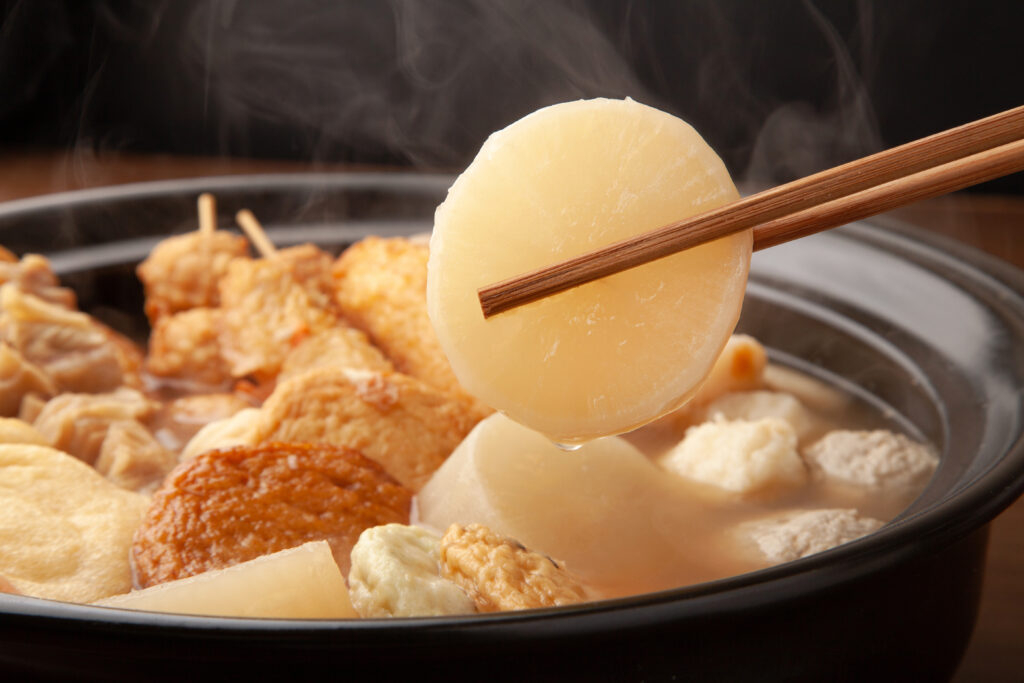
Oden is a typically Japanese comfort dish, perfect for cold winter days. This Japanese stew features a blend of ingredients slowly simmered in a light broth made with soy sauce and dashi. Common ingredients include daikon radish, hard-boiled eggs, konnyaku (konjac root jelly), and various fish balls. Every region and household in Japan has its own version of Oden, making it a very versatile dish.Oden is often sold in street stalls or konbinis, offering a quick and warming option for passers-by. It's a simple dish but deeply rooted in Japanese culinary culture, ideal for discovering the subtle flavors and conviviality of this cuisine.
18- Chankonabe
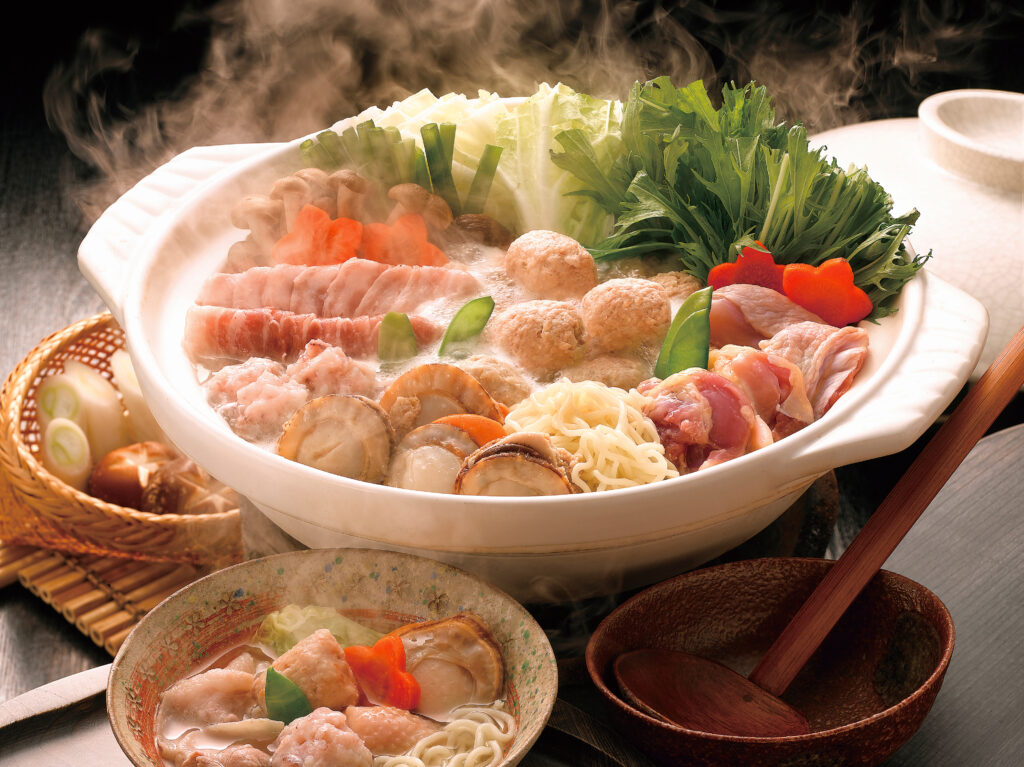
Chankonabe is a hearty and nourishing dish, often associated with Japanese sumos, who eat it to build muscle mass. This Japanese fondue is prepared with a rich broth in which various ingredients such as chicken, fish, tofu and a variety of vegetables like cabbage and mushrooms are simmered. Each sumo stable has its own recipe, but the principle remains the same: a protein- and nutrient-dense meal to support intensive training. Chankonabe is also very popular in specialized restaurants, where it is served in large portions, perfect for sharing with friends and family. When you try this dish, you'll discover not only a delicious flavor, but also a unique aspect of Japanese culinary culture.
19- Omurice

Omurice is a hybrid Japanese dish, born from the fusion of Western and Japanese cuisine, popular with children and anime fans alike. It's a fluffy omelette wrapped around sautéed rice, often cooked with ketchup and sometimes accompanied by chicken or vegetables. The whole thing is usually garnished with an artistic touch, such as a ketchup drawing, which adds a playful dimension to this comforting dish. Served in many cafés and restaurants,Omurice is easy to customize to your tastes, making it a simple yet incredibly satisfying meal. It's a perfect introduction to yoshoku (Japanese-style Western cooking) and a must for those looking to explore the fun and creative aspects of Japanese cuisine.
Discover Japan's most popular activities here:
You might also like to check out our must-sees in Nara and Tokyo!
What's the typical Japanese dish?
Sushi is often referred to as Japan's signature dish. It's an emblem of Japanese gastronomy, recognized the world over. Sushi consists of vinegar-coated rice accompanied by raw fish, seafood or other ingredients, and can be presented in a variety of forms, such as nigiri, maki or sashimi. This dish embodies the essence of Japanese cuisine: freshness, simplicity and attention to detail.
Other dishes, such as ramen (noodle soup), tempura (vegetable or seafood fritters), and sukiyaki (Japanese beef fondue), are also emblematic of Japan, but sushi remains the most symbolic and representative of Japanese culinary culture.
What's Tokyo's signature dish?
tokyo's signature dish is Monjayaki. This dish is a specialty of the Japanese capital and can be compared to a more liquid variant ofOkonomiyaki, which is a type of Japanese pancake. Monjayaki is prepared by mixing a flour-based dough with various ingredients such as cabbage, seafood, cheese or meat, then cooked directly on a hot plate. The ingredients are cooked first, then the batter is added around them to form a kind of pancake.
Which sweet Japanese speciality to try?
If you want to discover a sweet Japanese specialty, Mochi is a must-try. Mochi is a glutinous rice cake known for its unique, elastic texture. It comes in many varieties, among which Daifuku Mochi, which is filled with sweetened red bean paste (anko), is particularly popular. Another modern variant is the Iced Mochi, where the mochi is wrapped in a scoop of ice cream, offering a contrasting experience between the softness of the rice and the freshness of the ice cream.


